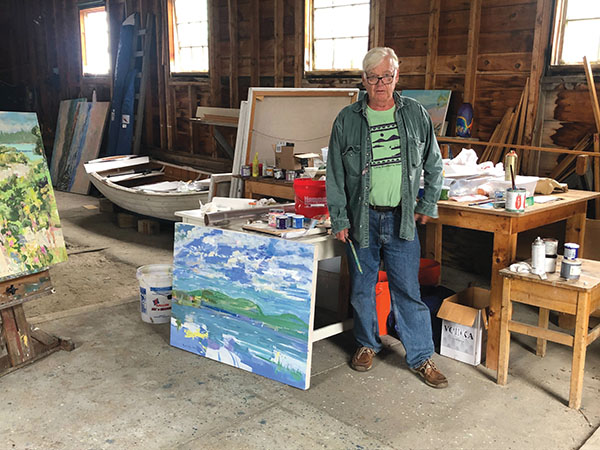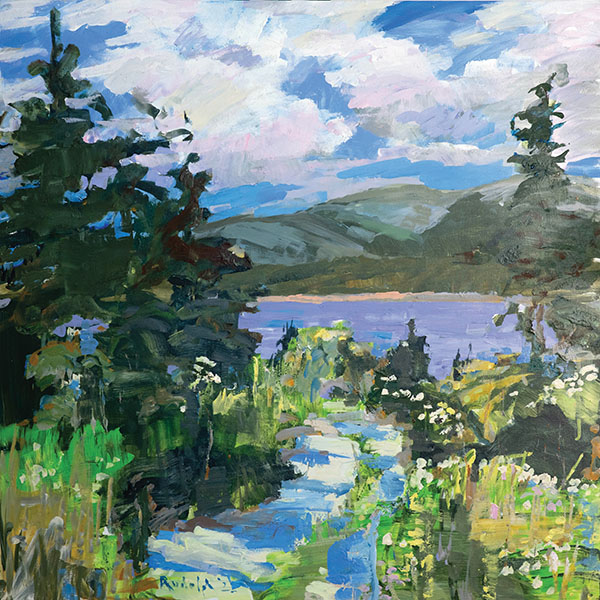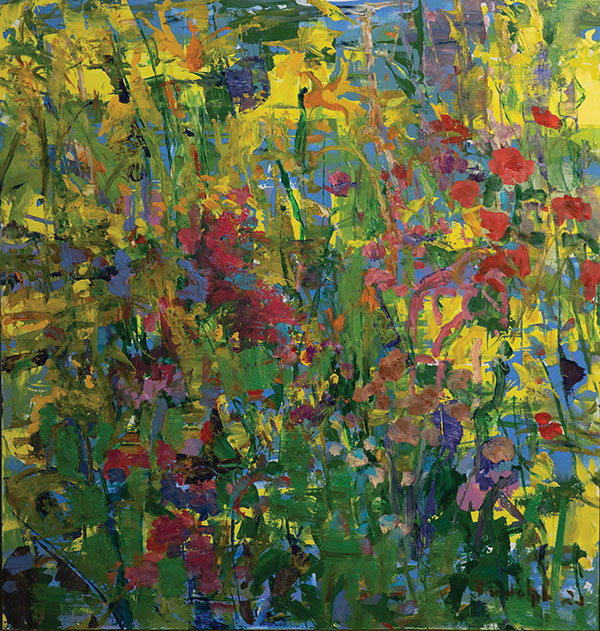Peter Rudolph

When a visitor asks Peter Rudolph to see his studio, the painter walks to a side door on the back porch of his home on Little Cranberry Island, aka Islesford, off the coast of Maine, descends a few steps, and pulls a blue tarp off a garden cart. There, revealed, is a mess of art-making materials—tubes of paint, brushes, turpentine, rags, etc.—awaiting his next foray to a nearby motif.
The cart will get him to the three different gardens on his property on Maypole Point Road. One garden features hybrid lilies that bloom in the middle of July; he’ll paint them then and there. As the summer proceeds, he will wheel the cart to other spots, seeking different colors and shapes.
For landscapes further afield on the island, Rudolph has a van, a “serious vehicle” he can drive just about anywhere. Over the 40 years he has been coming to Islesford, he has painted many corners of this sea-girt world which boasts some of the finest views of Mount Desert Island, a 20-minute mailboat ride away.
Rudolph also has a boathouse studio down the road a piece which he uses for storage and where he may fine-tune a canvas started outdoors. He tends to steer clear of the space: “It seems antithetical to make a studio painting when you live on an island,” he says.
Indeed, Rudolph only works from nature. “To me, it’s really all about painting,” he avers, “not about picture making”; he avoids photography, straight lines, “any of that stuff.” He likes seeing what he’s doing and making “instant decisions,” which result in canvases that have an expressionist immediacy and energy.
Many of Rudolph’s paintings are tuned to the weather and season. For example, Dutchman’s Pants, a view of Mount Desert Island, takes its title from the term for a patch of blue sky on an overcast day—an indication of clearing. The painting Early September is accented with the yellow of goldenrod, the quintessential fall wildflower.

In recent years Rudolph started using Flashe, a vinyl paint, as an undercoating. Several of his all-over garden pieces are backlit by this luminous foundation. Lively brushwork and a dazzling palette turn these canvases into vibrant fields of floral glory.
Rudolph makes his living as a gallerist and painting restorer. He bought the venerable McClees Galleries (founded in 1845) in Bryn Mawr, PA, 30 years ago. He specializes in 19th- and early 20th- century American and European artworks as well as fine art restoration.
Rudolph also owns the Clark Point Gallery in Southwest Harbor, ME, open seasonally since 2000. He launched the gallery because he kept cleaning
paintings of Maine by Philadelphia artists and thinking, wouldn’t it be great to repatriate them, bring them back to where they were made?
Over the years, Rudolph has mounted landmark shows featuring artists who worked in the Mount Desert Island area. Working with art historian Royal Leith, he highlighted the watercolors of Harold Warren (1859–1934), a follower of John Ruskin and a member of TIPs, the Three Islesford Artists. And thanks to his shows of Xanthus Smith (1839–1929), he has elevated this artist’s art-historical stature as a marine and landscape art master.

Born in 1946, Rudolph spent his formative years in and around New York City; he recalls his parents dropping him off at museums in lieu of hiring a babysitter. He traces his interest in art to his father, architectural renderer George Cooper Rudolph. His early art adventures included working as Willem de Kooning’s assistant one summer in Springs, NY, and befriending Hans Hoffman, his next-door neighbor in Provincetown, MA.
Rudolph studied at Syracuse University, the Tyler School of Art, and the University of Pennsylvania, benefitting from memorable teachers along the way, among them, Tetsuo Ochikubo, Roger Anliker, Elaine de Kooning, and Alex Katz. He later taught art at Tower Hill School in Wilmington, DE, and Germantown Friends School in Philadelphia before becoming an art dealer and restorer.
Rudolph’s sole gallery affiliation is the Islesford Artists Gallery on Little Cranberry Island. He has shown work there since Katy and Dan Fernald opened the space in 1986—he was one of the six original featured artists. The Fernalds have welcomed his support, be it constructive criticism or art-historical know-how. Mostly, they appreciate his paintings, which reflect his passion for this special place in Maine.
